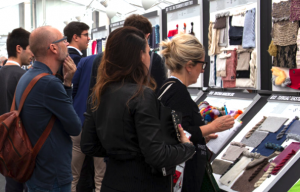
New yarns for knits area at Filo
Opinion


Janet Prescott reports from Milan Filo is always a business show, people get straight to the point. The latest edition, 10-11th October, in Milan, showed an increase in exhibitors, and business appeared brisk. This was despite lower production figures and higher imports registered in Italy for the sector during 2012.
19th October 2012
Janet Prescott
|
Milan
Filo is always a business show, people get straight to the point.
The latest edition, 10-11th October, in Milan, showed an increase in exhibitors, and business appeared brisk. This was despite lower production figures and higher imports registered in Italy for the sector during 2012.
Filo gave one of the first glimpses of SS 2014 to buyers, who besides coming to source specific yarns for knitting and weaving, were looking at ideas for a season which they are only just beginning to consider.
With the suggested colour palette for the new season fixed and confirmed by the spinners and Gianni Bologna’s trend area, Filo gave strong indications of consensus, which this time centred round blends and performance as priorities.
Visitors were mainly from Europe; Italy, France, and the UK, and the show also featured visitors from Japan. There was in addition a nucleus of Japanese exhibitors, two of them new to Filo this season, Hasegawa and Reiko, with design to the fore.
The Japanese yarns were some of the most interesting: returning Yamada Textile showed acrylic yarns with a papery handle, real paper yarns and printed chenilles in nylon polyester and also pvc yarns.
One Japanese exhibitor remarked that high quality production is in some cases being moved back to Japan from China to ensure consistency of fabric production and enabling quality control by the use of their own dye houses. Japanese company Hasegawa showed pure silk ribbon yarns plated with viscose to produce a yarn with the natural shine and properties of silk with the qualities of viscose on the outside.
Turkish exhibitors were mentioned as a source of reliable supplies and capacity at a reasonable cost with consistent quality, many have Italian tie-ups through co-operative ventures, buy-outs and other forms of association. Filidea, a company with feet in both Italy and Turkey, included yarns for specialist fabrics on circular, seamless or sock machines. With a collection of 200 different fibres, the range serviced is great, with apparel and hosiery through to protective wear and filtration.
Made in Italy, however, is the domestic theme throughout the exhibition, classed as a high priority In the press conference, always a key event at Filo, with the President of Unione Industria Biellese (UIB) Marilena Bolli and various industry speakers. The problem of falling Italian yarn production in the first quarter of the year was not ducked, after good figures for 2011, but the rather encouraging atmosphere this season was also noted as a sign, however amorphous, of optimism and a belief in the potential of design and quality.
Technical and performance yarns, flame retardant or antibacterial, indicated the flexibility and specialisation of many of the Italian companies whose mission all along has been to broaden their appeal and stay in business, preferably in Italy.
Knitwear is proving a growth area with buyers noting that “something is moving in knitwear”, certainly there were many more knitwear yarns on display, for both flat bed and circular knits, with finer yarns and ribbon constructions. At the press conference, the current vogue for tie-less men was seen as symbolising the new balance between the casual and formal which is undoubtedly affecting the prevalence of knit for both men and women.
There were very few yarns on display which were not blends. Blending is enabling different appearances and handle as well as sometimes affecting the price, with a larger proportion of synthetics mimicking the effects of precious fibres.
This is the luxury area, so although price is not flagged up as a priority, it is nevertheless true that more affordable ways to produce effects are being discussed in conversation some companies giving examples of blends with silk or as an alternative, viscose.
Many blends featured cashmere/silk, or silk/ linen, the latter chosen for an upmarket rustic looks with texture. 50% wool /30% mohair and 20% linen was a favourite combination. Fil 3 showed pure linen in different guises blended with cotton, silk or acetate for bright and shiny turquoise variations.
Sparkle and light effects in the yarn remained important. The Lurex stand was busy and showing light, fresh, white and transparent yarns which underpinned a great part of the themes of the season.
Lurex themes included watercolour tones in light purple, dark red and yellow imparted a light transparency to coloured fabrics. Copper, and brights like ruby, pea green, chestnut and blue jeans led trends in all fabric types, the Lurex yarns lending a transparent colour to the fabrics of the day. More overtly sparkling yarns highlighted space borealis, space pink, blue, yellow and iris.
Botto Poala drew together the threads of the ‘dressed up’ look which is contrasted with a new freer, casual look, with collections called ‘Ceremony’ and ‘Disco jacket’, using basic yarns and reverse twists for the construction fabrics with fancy effects. Silk, glitter and mercerised wools gave the impression of lights. Alashan pure cashmere 2/120s was an example pure luxury designed for accessories.
Some changes such as Filature Française de Mohair, now part of Safil, report increased popularity of mohair knitting yarns in 100% and blends with silk exploiting its lustre and breathability. Cape Mohair provides the fibre. Safil’s fine worsted yarns for flat knitting include wool/silk or wool/viscose versions, with a cool and crisp touch.
Color Coloris, the colour forecaster with a distinguished professional panel, has a strong interest in sustainability. For the new season, light and shade, natural effects, transparency and colour were flagged up, with the image of light on bubbles, larva, colours and textures and transparent effects were indicated to the trade.
Several companies with organic collections reported that after a period of quiet for several seasons, buyers were again asking for eco and certified yarns, a trend being driven by the end customer. Spoerry’s Ecotop, a high quality organic cotton, registered a substantial increase in interest, as did a well received new recycled linen and viscose blend. Marchi & Fildi showed an Ecotec cotton in various forms, while Tearfil, Portugal, reported strong demand for Fair trade and organic cotton.

Business intelligence for the fibre, textiles and apparel industries: technologies, innovations, markets, investments, trade policy, sourcing, strategy...
Find out more